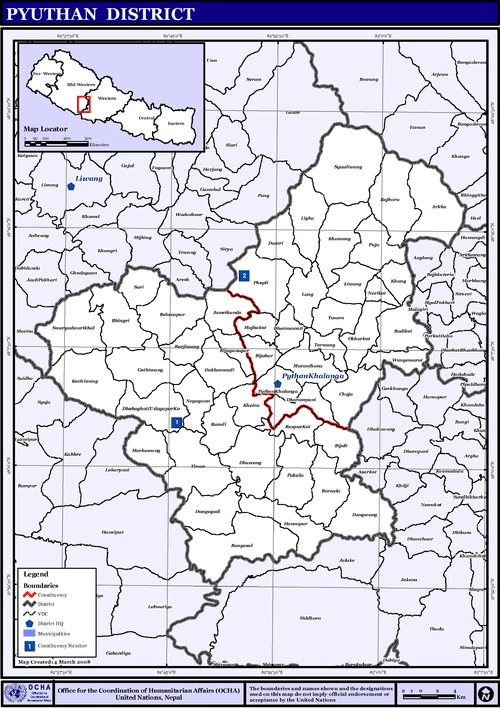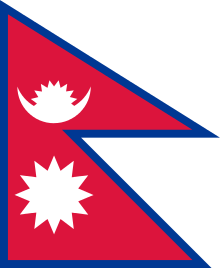Pyuthan District
| Pyuţhān Jillā प्युठान जिल्ला | |
|---|---|
| District | |
 Pyuthan (red) | |
| Country | Nepal |
| Region | Mid-Western (grey) |
| Zone | Rapti (darker grey) |
| Headquarters | Pyuthan |
| Area | |
| • Total | 1,309 km2 (505 sq mi) |
| Population (2011[1]) | |
| • Total | 226,796 |
| • Density | 170/km2 (450/sq mi) |
| Time zone | NPT (UTC+5:45) |
| Main language(s) | Nepali, Newari, Khamkura |
Coordinates: 28°05′N 082°50′E / 28.083°N 82.833°E
Pyuthan District(Nepali: प्युठान जिल्ला![]() Listen , is a "hill" district some 250 km west of Kathmandu in Province No. 5 in midwestern Nepal. Pyuthan covers an area of 1,309 km² with population of 212,484 in 2001 and 226,796 in 2011. Pyuthan Khalanga is the district's administrative center.
Listen , is a "hill" district some 250 km west of Kathmandu in Province No. 5 in midwestern Nepal. Pyuthan covers an area of 1,309 km² with population of 212,484 in 2001 and 226,796 in 2011. Pyuthan Khalanga is the district's administrative center.
Geography and Climate

Pyuthan borders Dang Deukhuri District to the southwest along the crest of the Mahabharat Range and extends about 50 km northeast through the Middle Hills to a 3,000+ meter ridge that is both Pyuthan's border with Baglung district of Dhaulagiri Zone and the main watershed between the (west) Rapti and Gandaki River basins.[2] Pyuthan borders Rolpa district to the west. Of the two upper tributaries of the West Rapti River, Pyuthan contains all of Jhimruk Khola and the lower part of Madi Khola after it exits Rolpa. The Madi-Jhimruk confluence is in southern Pyuthan, in the Mahabharat Range.[3] On the southeast Pyuthan borders Lumbini Zone including Arghakhanchi and Gulmi districts.
The valley of Jhimruk Khola is the core of Pyuthan district. Its alluvial plain is intensively planted in rice during the summer monsoon. Wheat is grown as the winter crop. Madi Khola has eroded an inner gorge and is less suited to traditional irrigated agriculture.
| Climate Zone[4] | Elevation Range | % of Area |
|---|---|---|
| Upper Tropical | 300 to 1,000 meters 1,000 to 3,300 ft. |
36.1% |
| Subtropical | 1,000 to 2,000 meters 3,300 to 6,600 ft. |
53.3% |
| Temperate | 2,000 to 3,000 meters 6,400 to 9,800 ft. |
9.7% |
| Subalpine | 3,000 to 4,000 meters 9,800 to 13,100 ft. |
0.8% |
Castes and Occupations
Bahun and Chhetri farmers cultivate irrigated fields along the Jhimruk and unirrigated fields partway up the hillsides. They are served by Newar merchants and service castes such as Damai (tailor/musician), Gaine (minstrel), Kami (blacksmith), Kumal (potter), Sarki (tanner/leatherworker) and Sunar (goldsmith). Highlands around the valley are mostly inhabited by Magars, including Kham Magars at higher elevations. The district center Pyuthan Khalanga is situated on a hillside east of the Jhimruk, some 500 meters above it.
Population by Census 1971-2011

Climate
The valleys have a subtropical climate with temperatures reaching 40 Celsius in May and falling to single digits in winter. There is a little too much winter chill for bananas and papayas. At about 800m elevation, the Jhimruk Valley approaches the upper limit for mangoes, however Madi Khola is lower. Citrus, Asian pear and mulberries are grown as cash crops in surrounding hills. Maize is grown on sloping un-irrigated bari fields up to about 2,000m. Snow occasionally falls on adjacent peaks reaching 2,400m but seldom lasts more than a day or two.
Infrastructure
At Cherneta the Jhimruk hydroelectric project exploits the Jhimruk bending within 2 km of Madi Khola[7] while some 200 meters higher. It has a capacity of 12 megawatts and supplies electricity for lighting, electronics and machinery. Electricity is considered too costly for cooking and heating, so firewood is still in widespread use with limited use of biogas.
Scheduled buses serve Pyuthan via a spur road off the main east-west Mahendra Highway at Bhalubang in Lalmitiya VDC, Deukhuri Valley.[8] An old trade route was upgraded for motor vehicles in conjunction with the Jhimruk hydro project and is now (2010) being paved. A longer, now less-traveled gravel road from Tribhuvannagar (Ghorahi) in Dang Valley traverses the Mahabharat Range to Tiram, then descends toward Madi Khola to join the Bhalubang road at Devisthan. The Madi is then followed 1 km. upstream to Chakchake where a left fork continues further upstream into Rolpa district while the main road climbs to cross a low pass at Cherneta and descend into the valley of Jhimruk Khola. At Bijuwar Bazaar about 10 km. beyond Chakchake this road forks again with a branch continuing north along the Jhimruk while the main road crosses the Jhimruk and climbs to Khalanga the district's administrative center.
History
Pyuthan was one of 24 small kingdoms in the Chaubisi Rajya confederation before Prithvi Narayan Shah unified modern Nepal in the second half of the 18th century. Since Dang Deukhuri District to the south and Salyan District to the west belonged to another confederation called Baise Rajya, Pyuthan was a western outpost of the Chaubisi and probably a defense perimeter defended by forts, for example at Okharkot.
Pyuthan is home district of Dr. Yadav Pandit a research scholar working in the field of Experimental Nuclear Physics. Dr. Pandit is an expert in measurements of anisotropy, studying fluid-like behavior and phase transitions in the dense and highly excited matter created in heavy ion collisions.
Pyuthan is also the home district of Mohan Bikram Singh (1935-), a founder of the Communist Party of Nepal. Singh's organizational work in Pyuthan and other districts of Rapti Zone laid the basis for the area becoming the so-called "heartland" of the Maoist insurgency 1996-2006 that cost over 12,000 lives but was instrumental in transforming the country from a kingdom ruled by the Shah dynasty into a republic. Other prominent communist leaders from Pyuthan include Mohan Baidhya, Lila Mani Pokhrel, Bamdev Gautam and Navraj Subedi.
Pyuthan is also the home district of Anirudra Sharma (Parliament 1959-1960), Sibraj Subedi (former minister and Parliament 1991-1998), Mukti Prasad Sharma of Nepali Congress Party (Parliament 1991-1914) and Khem Raj Pandit of the conservative and royalist Rastriya Prajatantra Party. Find more about some of the famous people from Pyuthan district at People from Pyuthan district
V.D.C.s (and other towns in parentheses)

- Arkha
- (Bagdula), Bandikot, Bangemarkot, Bangesal, Baraula, Barjibang, Belbas, Bhingri, Bijaya Nagar, Bijuli, Bijuwar
- Chunja
- Dakha Kwadi, Damri, Dangbang, Dharampani, Dharmawati, Dhobaghat, Dhubang, Dhungegadhi
- Gothibang
- Hansapur
- Jumrikanda
- Khabang, Khaira, Pyuthan Municipality, Khung, Kochibang, (Kwadi)
- Libang, Ligha, Lung
- Majhakot, Maranthana, Markabang
- Narikot, Naya Gaun
- Okharkot
- Pakala, Phopli, Puja
- Rajbara, Ramdi, Raspurkot, (Ratamata)
- (Sapdanda), Sari, Swargadwarikhal, Syaulibang
- (Tikuri), Tiram, Torbang, Tusara
- (Udayapurkot)
- Pandeydada khalanga
Historic and Cultural Sites
- Airabati, Asurkot
- Bandhikot, Bhagawati Temple, Bhawaniswari Temple, Bhimsensthan, Bhimsen Temple (Kutichaur), Bhimsen Temple (Megazun), Bhimsen Temple (Bijbazar), Bhitrikot Cave, Bhitrikot Durbar, Bhringri Kot, Bhumesthan (Khaira), Bijulikot, Birdisthan
- Chhetrapal Temple
- Devi Bhagawati, Devi Bhagawati Temple, Devi Temple, Dhunge Gadhi, Dubanasthan
- Ganesh Temple, Ganeshsthan, Gaumukhi, Gorakhnath Temple (Khaira), Gorakhnath Temple (Dakha Kwadi), Gorakhnath Temple (Bijbazar)
- Jalpadevi Temple, (Bijbazar – Bhagwati), Jalpadevi Temple (Bijbazar), Jhankristhan (Khaira)
- Kalidevi Temple, Kali Temple, Kalika Malika, Khadga Devata Temple, Khalanga Shivalaya, Khungrikot
- Laxmi Narayan Temple
- Masta Mandau, Mehelnath Temple
- Okharkot
- Phalaharisthan, Pyuthan Magazine
- Radha Krishna Temple, Rameswar Temple, Rani Pauwa
- Saraswati Temple, Sarikot, Shiva Temple (Khaira),Shiva Temple (Lung), Shiva Temple (Bangeshal), Shiva Temple (Khalanga), Shivalaya, Siddha Devatasthan (Belbas), Siddha Sansarsthan (Dakha Kwadi)
- Swargadwari—a hilltop temple complex and pilgrimage site celebrating the importance of cows in Hinduism—is located in the southern part of Pyuthan.
- Tatopani Shivalaya, Tripurasundari, Tusharakot Isnasthan
- Udayapur Kot
- Pandeydada khalanga Shree Satyadevi Bhagwati Mandir, 12-bhai Baraha Dev Mandir
Maps
- Besides the United Nations/Nepal map of districts and VDCs shown above, their Map Centre[10] has a downloadable PDF version adding municipalities, roads and water detail:
- "Pyuthan District" (PDF) (Map). Retrieved Jan 31, 2014. Missing or empty
|title=(help)
- "Pyuthan District" (PDF) (Map). Retrieved Jan 31, 2014. Missing or empty
- From 1992 to 2002 a definitive series of large scale topographic maps were surveyed and published through a joint project by Government of Nepal Survey Department[11] and Finland's Ministry for Foreign Affairs contracting through the FinnMap consulting firm.[12] Japan International Cooperation Agency[13] substituted for FinnMap in Lumbini Zone.
- Topographic sheets at 1:25,000 scale covering 7.5 minutes latitude and longitude map the Terai and Middle Mountains. Less populated high mountain regions are on 15 minute sheets at 1:50,000. JPG scans can be downloaded here:[14]
- These sheets cover Pyuthan District:
- 2782 3B "Hasipur" (1998)
- 2782 4A "Bangesal" (1997)
- 2782 4B "Amili" (1998)
- 2783 1A "Dhanchaur" (1998)
- 2882 12C "Gam" (1999)
- 2882 12D "Shauliban" (1999)
- 2882 15A "Holeri" (1999)
- 2882 15B "Khungrichaur" (1999)
- 2882 15C "Bach Pokhara" (1998)
- 2882 15D "Swargadwari" (1999)
- 2882 16A "Sirpa" (1998)
- 2882 16B "Machchhi" (1999)
- 2882 16C "Bijuwar" (1998)
- 2882 16D "Pyuthan Khalanga" (1998)
- 2883 09C "Rajawara" (1999)
- 2883 13A "Purkot Daha" (1998)
- 2883 13C "Bamruk" (1999)
References
- ↑ Central Bureau of Statistics, Kathmandu, Nepal, Jan. 2014
- ↑ http://www.cbs.gov.np/Gis_Maps/General/Major%20Rivers.gif near 28.3N latitude, 83E longitude
- ↑ http://www.cbs.gov.np/Gis_Maps/General/Major%20Rivers.gif near 27.9N latitude, 82.9E longitude
- ↑ The Map of Potential Vegetation of Nepal - a forestry/agroecological/biodiversity classification system (PDF), . Forest & Landscape Development and Environment Series 2-2005 and CFC-TIS Document Series No.110., 2005, ISBN 87-7903-210-9, retrieved Nov 22, 2013 horizontal tab character in
|series=at position 91 (help) - ↑
- "Districts of Nepal". Statoids. Gwillim Law. Retrieved January 23, 2014.
- ↑
- National Population and Housing Census 2011, Volume 3 (PDF). Kathmandu, Nepal: Government of Nepal, Central Bureau of Statistics. January 2014. Retrieved January 23, 2014.
- ↑ http://www.cbs.gov.np/Gis_Maps/General/Major%20Rivers.gif near 28.1N latitude, 82.8E longitude
- ↑ http://www.un.org.np/maps/district-maps/mid-western/Pyuthan.pdf Detailed map of Pyuthan showing streams and roads as well as political subdivisions
- ↑ Bhandari, Bishnu, ed. (1997). Inventory of heritage sites in Nepal. Kathmandu: IUCN Nepal. Retrieved April 15, 2011.
- ↑ "Map Centre". United Nations, Nepal Information Platform. Retrieved February 4, 2014.
- ↑ "Government of Nepal, Survey Department". Retrieved February 4, 2014.
- ↑ "Land Administration & Management, Mapping, Surveying and Aerial Photography, Major Reference Projects" (PDF). FinnMap. Retrieved February 4, 2014.
- ↑ "Japan International Cooperation Agency". Retrieved February 4, 2014.
- ↑ "Nepal-Topo Maps". PAHAR Mountains of Central Asia Digital Dataset. Retrieved February 4, 2014.
External links
| Wikimedia Commons has media related to Pyuthan District. |
